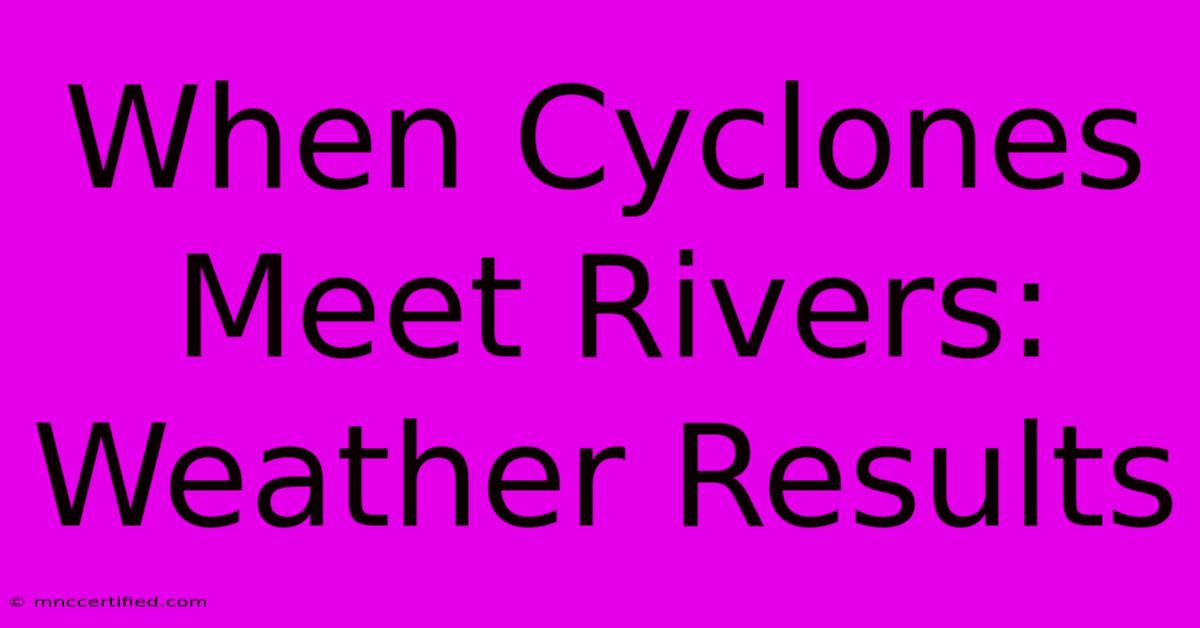When Cyclones Meet Rivers: Weather Results

Table of Contents
When Cyclones Meet Rivers: Weather Results & Devastating Impacts
Cyclones, with their ferocious winds and torrential rainfall, are devastating natural events. When these powerful storms interact with major river systems, the consequences can be amplified dramatically, leading to catastrophic flooding and widespread destruction. Understanding the complex interplay between cyclones and rivers is crucial for effective disaster preparedness and mitigation. This article delves into the weather results and devastating impacts of this perilous combination.
The Science Behind the Destruction: How Cyclones Impact Rivers
The interaction between cyclones and rivers is a complex dance of meteorological and hydrological forces. Several key factors contribute to the amplified impact:
1. Intense Rainfall: The Flooding Trigger
Cyclones are notorious for their torrential rainfall. This intense precipitation significantly increases river discharge, rapidly exceeding the capacity of river channels and leading to widespread flooding. The volume of water unleashed can be immense, transforming normally navigable waterways into raging torrents.
2. Storm Surge: Coastal Inundation and River Backflow
Coastal regions bear the brunt of cyclone-induced storm surges, where sea levels rise dramatically due to strong winds and low atmospheric pressure. This surge doesn't just inundate coastal areas; it also pushes seawater far upstream into rivers, causing river backflow and exacerbating flooding in inland regions. This saltwater intrusion can also contaminate freshwater sources, impacting agriculture and drinking water supplies.
3. Wind-Driven Waves: Erosion and River Bank Instability
The powerful winds associated with cyclones generate large waves, even on inland rivers. These waves cause significant erosion of riverbanks, weakening their structural integrity and further contributing to flooding. Riverbank collapse can lead to displacement of communities living near riverbanks and disrupt crucial infrastructure like bridges and roads.
4. Increased Sedimentation: Long-Term Environmental Impact
Cyclones carry vast amounts of sediment, soil, and debris into rivers. This increased sedimentation can alter river morphology, impacting navigation, water quality, and aquatic ecosystems. The long-term consequences of altered river systems can be significant, affecting biodiversity and the livelihoods of communities reliant on the river for their survival.
Devastating Impacts: A Cascade of Catastrophes
The consequences of cyclones interacting with rivers are far-reaching and severe:
1. Catastrophic Flooding: Loss of Life and Property
The most immediate and devastating impact is widespread and often catastrophic flooding. Homes are inundated, infrastructure is destroyed, and tragically, lives are lost. The scale of the destruction can be overwhelming, requiring massive rescue and relief efforts.
2. Infrastructure Damage: Disruption of Essential Services
Cyclone-induced flooding severely damages critical infrastructure, including roads, bridges, power lines, and communication networks. This disruption of essential services hinders rescue operations, slows down recovery efforts, and impacts the economy.
3. Agricultural Losses: Food Security at Risk
Flooding caused by cyclones destroys crops and livestock, impacting food security and livelihoods, particularly in agricultural communities dependent on river systems. Saltwater intrusion can further damage agricultural land, making it unsuitable for cultivation for extended periods.
4. Waterborne Diseases: Health Crisis
Stagnant floodwaters create breeding grounds for disease-carrying mosquitoes and other pathogens, leading to outbreaks of waterborne diseases such as cholera and typhoid. This health crisis adds another layer of complexity to the aftermath of a cyclone.
5. Displacement and Migration: Social and Economic Upheaval
Flooding often forces communities to evacuate their homes, leading to displacement and migration. This upheaval causes social and economic disruption, particularly for vulnerable populations.
Mitigation and Preparedness: Building Resilience
Minimizing the impacts of cyclones on river systems requires a multi-pronged approach focused on:
- Improved forecasting and early warning systems: Accurate predictions are crucial for effective evacuation and preparedness.
- Strengthening infrastructure: Building resilient infrastructure capable of withstanding flooding and storm surges is essential.
- Implementing effective land-use planning: Careful planning can minimize development in high-risk areas.
- Community-based disaster preparedness: Educating communities about cyclone risks and developing effective emergency response plans are vital.
- Investing in river management and restoration: Maintaining healthy river systems with sufficient capacity to handle increased water flow is crucial.
By understanding the complex interaction between cyclones and rivers and implementing robust mitigation strategies, we can strive to build more resilient communities and minimize the devastating impacts of these powerful natural events. The key lies in proactive planning, effective communication, and a collective commitment to disaster preparedness.

Thank you for visiting our website wich cover about When Cyclones Meet Rivers: Weather Results. We hope the information provided has been useful to you. Feel free to contact us if you have any questions or need further assistance. See you next time and dont miss to bookmark.
Featured Posts
-
Farm Bureau Car Rental Insurance
Nov 21, 2024
-
Money Back Life Insurance Canada
Nov 21, 2024
-
Can You Cancel A Insurance Claim
Nov 21, 2024
-
Bitcoin On Base Price Prediction
Nov 21, 2024
-
Russell Westbrook Referees Under Fire
Nov 21, 2024